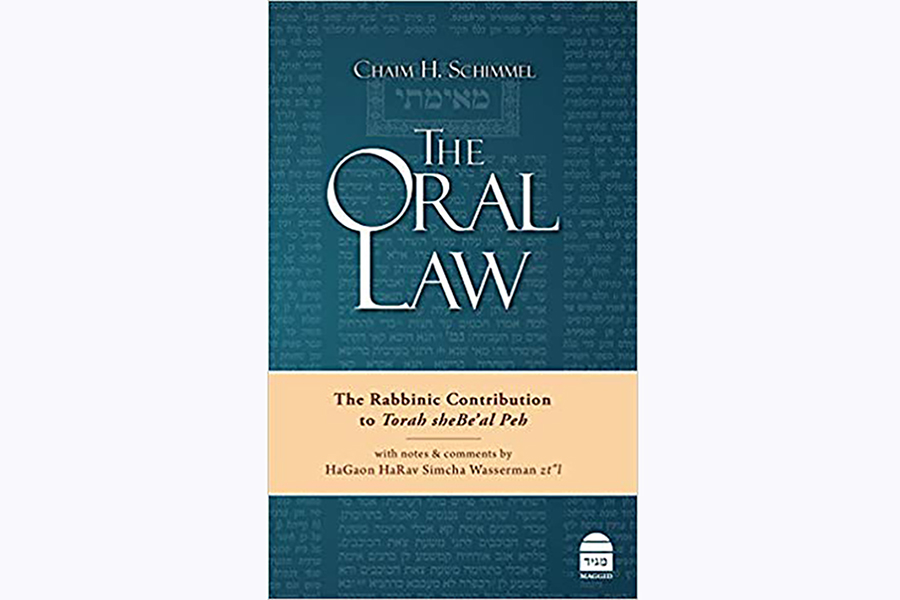Title: The Oral Law: The Rabbinic Contribution to Torah sheBe’al Peh
Publisher: Maggid Press
By Rabbi Chaim H. Schimmel
‘);
_avp.push({ tagid: article_top_ad_tagid, alias: ‘/’, type: ‘banner’, zid: ThisAdID, pid: 16, secure: true });
Is there any value in trying to understand the origins and development of the Oral Torah? The Five Books of Moshe were dictated by G-d to Moshe and the remainder of the Bible was written by various prophets under inspiration. Where do the Mishnah and Talmud come from? More important than authorship of the great Jewish works is the origin of their laws and ideas. Does a committed Jew gain anything from exploring all that has been written on this subject?
Rebellious Jews have long rejected the Oral Torah, whether Sadducees, Karaites or otherwise. In response, great rabbis have addressed the history of the Oral Torah. For example, Rambam discusses the history, theology and technical details of the Oral Torah in his introduction to his commentary on the Mishnah and his classic halachic work, Mishneh Torah. Like others, Rambam had to work backwards in reconstructing this description.
The Mishnah and Gemara spare little room for methodical descriptions of the Oral Torah. The Mishnah focuses on laws and the Gemara adopts a style of free-flowing discussion rather than methodical progression. By doing so, the texts more effectively teach the ideas and methods of the Torah, engaging students in its direct study rather than talking about the Torah’s background. Instead, we have piecemeal comments across rabbinic literature, by different rabbis living in different times and places. Unlike in later generations, at that time there was no need for a comprehensive catalog. As often occurs in Talmudic study, the puzzle pieces are put together slightly differently by various commentators.
In The Oral Law, Rabbi Chaim H. Schimmel summarizes the consensus approach based on Rambam’s writings and subsequent discussions. Originally published in 1971 with comments from Rav Simcha Wasserman, and extensively revised in 2019 with a new foreword by Rabbi Lord Jonathan Sacks, this book systematically explains the history and methods of the Oral Torah utilizing a combination of yeshiva-based texts, such as Rav Elchanan Wasserman’s Kovetz Shiurim, with moderate academic treatments of the subject, such as Prof. Chanoch Albeck’s Mavo Le-Mishnah.
Broadly speaking, the Written Torah was given in the Sinai Desert together with an Oral Torah that contains instructions on the details of the laws and additional laws and ideas not recorded in writing at that time. Throughout the subsequent centuries, both the Written and Oral Torahs were taught and observed. Additionally, methods to interpret the Written Torah (hermeneutic rules) were given together with the text, so the Sages could appropriately understand the sacred writings and – most significantly – deduce laws from the biblical words.
Here is where confusion arises and debate ensues. Sometimes the Sages decreed new laws – rabbinic legislation. Sometimes they interpreted the text using the hermeneutic rules. The former is de’rabbanan, of rabbinic origin and not claimed to have come down to us from Sinai. The latter is de’oraisa, biblical law. When the rabbis used these hermeneutic rules, which we can see debated throughout the Midrash and Talmud, were they using hermeneutic rules to derive new laws and details, or were they merely finding hints in the text for traditions already existent in the Oral Torah from Sinai?
To the Talmud student, this is a big question. We spend so much time breaking our teeth trying to understand these clashing interpretations. Are these just hints for what the Sages already knew or did they really believe they were deriving new laws from these textual cues? Rambam leaves room for both but does not tell us how often each method is used. The great Malbim of the nineteenth century, who was defending Judaism from Haskalah critics, argues at great length that these are legitimate derivations. Rav Yitzchak Halevy, in his classic history Doros Harishonim, harshly criticizes Malbim and argues that the Sages mostly searched for hints to laws they already knew from tradition. Rabbi Schimmel gently asks in a footnote why, according to Rav Halevy, the Sages of the Talmud debated ”so fiercely” what he considers to be mere hints.
Rabbi Schimmel’s greatest contribution, aside from his organization and clarity, is his discussion of the rabbinic mind. According to the author, the Sages used logic and moral reasoning (sevara) to interpret the text and derive laws. Rav Simcha Wasserman, in one of his comments to the book, disagrees that logic is a unique category and classifies it as one of the hermeneutic rules. The Oral Torah, and Judaism as a whole, is based on logic and morality. According to Rav Shmuel Landau (son of the Noda Bi-Yehudah), the Sages applied to a law that seemed to them contrary to reason (sevara) the limitation of “ein bo ela chidusho,“ a restriction against expanding the law. Rabbi Schimmel expands this by applying it to moral reasoning, as well. The law itself must be moral, even if we cannot fully comprehend it, but the Sages refrain from expanding this law because they found it morally surprising, contrary to the conclusion they would have reached on their own (see Lechem Mishneh, Hilchos Mamrim 7:11).
Rabbi Schimmel concludes his discussion with a quotation from Rambam’s Mishneh Torah (Hilchos Me’ilah 8:8), encouraging people to search for explanations of the Torah’s laws but cautioning against treating lightly laws you may fail to understand. If something seems illogical or immoral to the student, he needs to refine his understanding of the Talmud or his skills of logic and sense of morality.
Rabbi Schimmel addresses many more, equally complex subjects. He distinguishes between a legal fiction as found in British law and an artifice (ha’aramah) found in Jewish law. The former is intended to circumvent the law while the latter is designed to strengthen and guard the law. The author also discusses rabbinic enactments and legislation – their textual legitimacy and their authority. He addresses the writing of the Mishnah and its redaction, and its relation and contrast to Midrash. These subjects have been widely treated but Rabbi Schimmel presents them in a clear and very relevant way to the contemporary reader, adding his own insights along the way. This book was a classic when published and, on revision, has managed to become a new classic all over again. A beginner will benefit from this overview as he delves into the world of the Talmud while an experienced scholar will appreciate the work of putting together all these disparate pieces into a comprehensive whole.
‘);
_avp.push({ tagid: article_top_ad_tagid, alias: ‘/’, type: ‘banner’, zid: ThisAdID, pid: 16, onscroll: 10 });




